When digital cameras first started to gain momentum in the early 21st century, they came with many conveniences over film, one of which was eliminating the recurring cost of buying film and having it developed. With a digital camera, once you pay for the camera, every photo you ever take from that day forward has no additional cost.
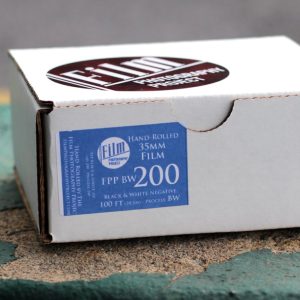
Shooting film is, and has always been expensive, and in some cases is even more expensive today as the few remaining film stocks carry premium prices, and lab development costs have skyrocketed, so for someone who still regularly shoots film, you need to find ways to minimize the cost factor. Developing your own film at home is a great way, but beyond that, bulk loading is another great option.
Of course, saving money through bulk loading is hardly a secret. Photographers have been doing this since the very first cameras were built, yet it surprises me how many people have never tried it. Bulk film is still easily available today through places like the Film Photography Project, Adorama, and other film supply stores for between $50 – $100 depending on stock. As an alternative, expired rolls of film stocks that are no longer being made are widely available on eBay and etsy for purchase. Although expired, this film almost always is still usable, albeit with a slight change of exposure.
In this week’s edition of Keppler’s Vault, we take a look at an article from the August 1964 issue of Popular Photography written by Cora Wright, who covers the basics of how it’s done. Cora covers three different loaders, the Watson 66B, Lloyd Bulk Loader, and the pre-loaded ANSCO Easy Loader. Coincidentally, of those three, I have a Watson and Lloyd loader, along with an Alden 74 loader.
Between the 3 types of bulk loaders I’ve used, I much prefer the Watson and Alden designs as they not only have an easy to use exposure counter so you can measure how much film you are loading into the cassette, but they also don’t rely on a felt lined film trap like the Lloyd which can very easily scratch your film. I bought each of these 3 loaders on eBay for no more than $10 – $20 each, and if you’re lucky, sometimes you can even find them with a partial roll of film still inside!
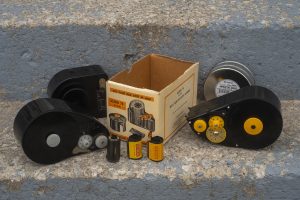
The article also covers which types of film cassettes are reloadable. The earliest 35mm cassettes were of the “Leica” style in which the entire thing was made of metal and it had door that was opened and closed via a lock in the bottom plate of the camera it was installed into. In the mid 20th century, many manufacturers sold reloadable cartridges with screw or snap on tops that could easily be opened for installing film, but many commercially available cassettes could be used as well. In the previous image to the right, I have both a Nikon branded metal cassette, along with two commercial Kodak cassettes that can be easily opened.
The article closes with a handy checklist of things to do before, during, and after loading, along with a price list at the very end of what bulk film cost back in 1964. Boy, would I love to buy 100 feet of Panatomic-X for $8.25! Aside from the price list, nearly all of the information in this article is still relevant today. Cora Right wrote this article in the hope of convincing more people to give bulk loading a try, and I hopefully my efforts of republishing it here can do the same thing!
All scans used with permission by Marc Bergman, 2019.





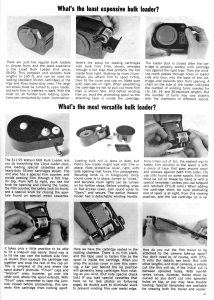
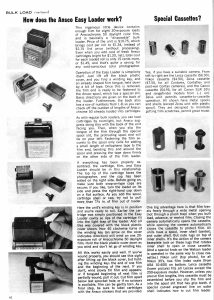
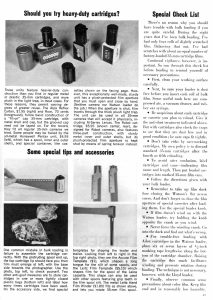
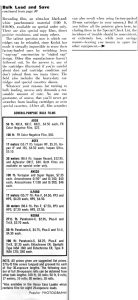
The bulk film days began in the mid-1960’s at college, when I read about the Watson 66 unit and ordered a catalog from Freestyle Sales company. With a dozen or more Kodak Snap Cap 35mm film cartridges, I was soon trying out a number of “generic ASA 50-400 black-and-white 35mm bulk film” rolls.
That’s when I discovered Ilford black-and-white films, which weren’t available at the local camera store. Pan F, FP3, and HP3 were additional “brushes” in the photographer’s film palette. Starting with HC-110 Dilution B (1:31), then on to D-76, and even Dektol, photography on a budget led to a Durst M301 enlarger and a “closet darkroom.”
In short order, I tried a “Euorpean black-and-white 35mm film” that turned out to be ORWO black-and-white films that responded best to Agfa Rodinal in 1:25 or 1:50 dilution rates. “Scratching an itch,” I ordered some 120 ORWO film and found it have a tonality quite different from Verichrome Pan 120.
Eventually, I decided to try bulk Kodak 35mm color film, which came in a variety of interesting letter/number designations quite unlike garden variety Ektachrome-X (ASA 64) or High Speed Ektachrome (ASA 160). By this time, I was “loading in the dark, counting clicks” just to get a usable-from-end-to-end like the “store bought” rolls of film. (There had been more than one occasion when “frame #38” was lost due to following daylight load directions.)
I also discovered DuPont film and Varigam enlarging paper via Freestyle Sales, which intrigued me as much as Agfa enlarging papers.
The final iteration of bulk film reloaded film culminated in the Summer of 1970, when i took the biggest gamble of all; using 35mm reloads on a trip to Japan! It was a real roll of the dice to carry metal film cans full of 20 exposure “High Speed Ektachrome” but I was saddled with slow lenses on Ye Olde Nikkormat FTn. This was the year of Expo 70, Fujifilm’s ST-701, and almost-ready-for-C22-and-E4 films from Sakura and Fuji. Long story short, I tested the bulk Ektachrome by having a roll or two developed in Japan, along with rolls of Sakura and Fuji slide fim. It worked just fine, and I envied the ASA 100 films available in Japan. (Eastman Kodak insisted that ASA 80 was good enough.)
Over the long term, the Ektachrome slides survived for decades, while the Sakura and Fuji slides faded, as had Anscochrome slides. I don’t recall what happened to the one roll of Agfachrome 64 slides went, so how that film aged is unknown. Please excuse the length of this post, these were exciting days back then, when EKC ruled the world.